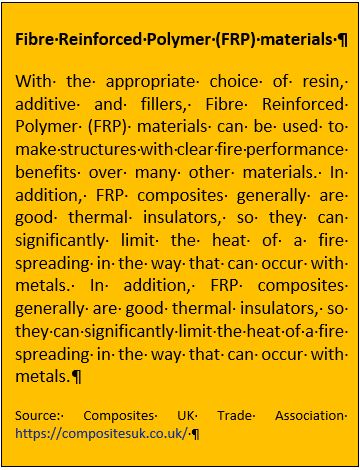- Discover how we are helping Members reduce emissions: Explore the ProjectGHG hub now.
- Join the global DP Community at the IMCA DP Conference in Amsterdam. 21 and 22 May. Book now
- Register your interest for the IMCA Global Summit 2024. 3-4 December, Utrecht, Netherlands.
- Now booking. Underwater Ship Husbandry Seminar. 10 October 2024, Singapore.
Fires on materials made of fibre-reinforced plastic (FRP)
What happened?
A member reports that serious fires have broken out on vessels with fibre-reinforced plastic (FRP) materials. They appear to have been caused by overheating of the FRP from hot exhaust systems. FRP is combustible and introduces several challenges compared to traditional non-combustible materials. It is imperative that safety barriers and fire safety measures are in place.

Incident 1
A fire was thought to have originated in FRP panels above the exhaust in an area between the main engine room and the adjacent casing. Maintenance of the engines had previously been carried out, requiring removal of insulation. The fire was contained, but with extensive material damage.
Incident 2
A fire had likely started in a compartment with direct access to open air and adjacent to an auxiliary engine room. The engine exhaust was routed through the compartment housing the silencer or muffler. A low-pressure cooling water alarm was experienced followed by a high temperature cooling water alarm, but without activation of the automatic engine shutdown. The vessel had to be evacuated and was declared a total loss
In both cases, there were no reported injuries to any persons.
What went wrong? What were the causes?
The immediate causes of the fires were likely to be due to:
- Combination of missing insulation on FRP structural surfaces exposed to heat radiation or direct contact with hot exhaust parts and limited engine room ventilation;
- Overheating of exhausts could also develop suddenly due to insufficient cooling water;
- Issues with temperature sensors or the malfunction of the shutdown system.
The ignition point of FRP materials is typically around 275° to 375°C, which is relatively low compared to metallic materials, i.e. aluminium alloys or steel. The typical operating temperatures of engines and exhausts can be considerably higher and there is an inherent risk of fire if safety measures are not satisfactorily arranged or managed.
Recommendations
- Thorough and regular maintenance of machinery and associated parts, with regular check of known or potential hot spots and any signs of overheating;
- When removal of insulation is necessary during modifications or other work, the insulation should be correctly reinstalled and restored to at least the original condition;
- Adequate training of vessel crew for emergency preparedness.
Members may wish to refer to the following incidents:
- Fire in engine space on crew transfer vessel (CTV)
-
Sorry, there is a problem with the link – please let us know.
- Engine room fires – Appropriate use of insulating material on hot surfaces
Safety Event
Published: 15 December 2017
Download: IMCA SF 31/17
IMCA Safety Flashes
Submit a Report
IMCA Safety Flashes summarise key safety matters and incidents, allowing lessons to be more easily learnt for the benefit of all. The effectiveness of the IMCA Safety Flash system depends on Members sharing information and so avoiding repeat incidents. Please consider adding [email protected] to your internal distribution list for safety alerts or manually submitting information on incidents you consider may be relevant. All information is anonymised or sanitised, as appropriate.
IMCA’s store terms and conditions (https://www.imca-int.com/legal-notices/terms/) apply to all downloads from IMCA’s website, including this document.
IMCA makes every effort to ensure the accuracy and reliability of the data contained in the documents it publishes, but IMCA shall not be liable for any guidance and/or recommendation and/or statement herein contained. The information contained in this document does not fulfil or replace any individual’s or Member's legal, regulatory or other duties or obligations in respect of their operations. Individuals and Members remain solely responsible for the safe, lawful and proper conduct of their operations.
